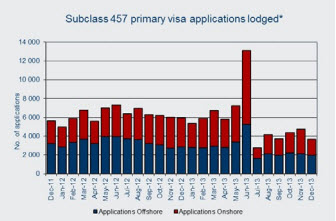457 Visa Applications Remain At Historic Low Levels
In July 2013 a number of government changes started taking effect for 457 visa applicants from means testing to dramatically higher application fees. The initial quarter after these changes saw a 13% drop in applications but the most recent figures for the October to December 2013 figures are the first to show the effect of all the policy changes.
The results below show that last quarter approximately 38% fewer applications were made for 457 visas compared to the same time last year. In real terms this is a decrease in 23,420 skill workers looking to move to Australia under the program.

457 Visa Applications Lodged
When looking at which group of employees class applications dropped, the results are relatively even. The number of managers dropped by 31.5% while professionals dropped by 33.1%.
While applications dropped by 38% the actual number of visa’s granted was approximately 24% lower year on year or 27,330 in real terms. While no formal reason has been provided by Department of Immigration and Border Protection (DIBP) or the government 457VisaCompared believes the key reasons for the difference are due to:
- The high influx of applications in July and September caused a backlog with DIBP processing times which may have bridged the gap in the October-December period
- The increased fees of applications may be leading applicants to be more thorough before lodging their application (and possibly choosing to use a migrant agent) reducing rejection rates of applications

457 Visa Grants
The main states where 457 visa applications and grants occurred were in the resource right states of WA and QLD which decreased by 50% and 46% respectively. Most other states and territories also saw declines but to a lesser extent.
The final statistic is less relevant as its a long term trend shown by DIBP which is the number of 457 visa holders in Australia. This number was 8.3% higher then the previous year but this was due to the artificial influx of applicants just before the 457 visa changes were made. As applications and grants continue to decline at a dramatic rate this long term index will reduce which may lead to political change which has already been flagged by members of the liberal party.
Cooks in 2013 have become the largest employment group to apply for 457 visas. They now represent 5.7% of all 457 visa holders (up from 4%). Restaurant managers and then developer programmers were the next two employment group. An interesting statistic is that the average 457 visa holder’s wage is $85,000AUD which is well above the national average and highlights the skill-set that these visa holders have when they enter Australia. Indians remains the higher citizenship group to take out 457 visa holders and now account for just over 23% of all applications followed UK citizens (19%) and Irish citizens at 8%. While most country citizens decrease in applications its worth noting that China’s were up just under 10% highlighting that many Chinese consider Australia still a desirable place to live.
Over 24,000 457 visa holders chose to become an Australian permanent resident which is an increase of just over 44%. Clearly this is a key selling point of the 457 visa and remains a key selling point of this temporary working visa over other options both domestically and globally.
Editors Forecast
2014 will be an interesting year for the 457 visa program. While it remains a unique program with a strong ‘carrot’ of permanent residency for those that work through the program the popularity may be tested by expected higher unemployment rate and lower Australia dollar. These both are a key factor that impacts skilled migration as individuals are only willing to work where the opportunity is and there the salary rates make it worthwhile. In recent years the high Australian dollar has meant that many skilled employees in countries like the UK moved to Australia not only based on the lifestyle but also on the fact they can earn more money. The combination of these two factors, higher cost of living elements such as 457 health insurance which is expected to increase in April and the higher application fees could see a continual decline is applicants which may once again become a political issue.
